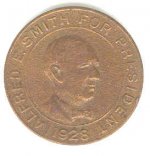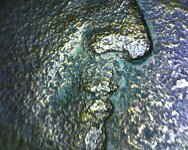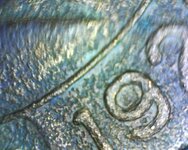artyfacts
Bronze Member
- May 1, 2010
- 1,144
- 1,239
- 🥇 Banner finds
- 3
- Detector(s) used
- Whites DFX, MX7, Minelab Manticore
- Primary Interest:
- All Treasure Hunting
Micro Abrasive Sandblaster & Baking Powder
I responded with this to a post, but felt this deserved its own thread. I use baking powder in my micro sandblaster for cooked and stained coins & artifacts of lesser value to experiment on. The baking soda is abrasive enough, smaller than 5/1000s, it falls through my screen which is 5/1000's its probably closer to 1 or 2 /1000's, One of the advantages is, you can see your progress as its being cleaned. If you try this technique, make sure you have a water moisture separator as close to the micro blaster as possible. Start with the tip away from item being cleaned and slowly get it closer until you see progress. You can back the tip off slowing the amount of pressure and abrasive giving you control. Use a old penny to practice on to give you an idea of the removal rate dictating the pressure (distance) used and also starting points (how far away to start without effecting object). Keep the tip a constant distance once you see a change on the surface of object giving you a nice even cleaning. Remember the key word, micro abrasive. The presidential race coin was cleaned but badly stained pitted and nasty, not to my liking, sorry no before pics. Since this was for my collection I wanted it to look its best and blasted the stains off. For coins & artifacts with obscure dates, words or details, you can use this technique, blast a little, recheck for any possible hints of said, and repeat if necessary. This is an abrasive, if used slowly you can remove just about anything. Some exclusions, rubber and other dense spongy materials. The abrasive quality of the baking powder is very fine and minute, if used correctly it can take off unwanted materials and still leave sharp details on coins and relics. Make sure you empty blaster and clear all lines after use, it will cake clogging small ports, clear blaster after emptying hopper using just air. Use common sense on which objects you blast, I will repeat this, it is an abrasive. Experiment, and the most important, experiment. Arty
I responded with this to a post, but felt this deserved its own thread. I use baking powder in my micro sandblaster for cooked and stained coins & artifacts of lesser value to experiment on. The baking soda is abrasive enough, smaller than 5/1000s, it falls through my screen which is 5/1000's its probably closer to 1 or 2 /1000's, One of the advantages is, you can see your progress as its being cleaned. If you try this technique, make sure you have a water moisture separator as close to the micro blaster as possible. Start with the tip away from item being cleaned and slowly get it closer until you see progress. You can back the tip off slowing the amount of pressure and abrasive giving you control. Use a old penny to practice on to give you an idea of the removal rate dictating the pressure (distance) used and also starting points (how far away to start without effecting object). Keep the tip a constant distance once you see a change on the surface of object giving you a nice even cleaning. Remember the key word, micro abrasive. The presidential race coin was cleaned but badly stained pitted and nasty, not to my liking, sorry no before pics. Since this was for my collection I wanted it to look its best and blasted the stains off. For coins & artifacts with obscure dates, words or details, you can use this technique, blast a little, recheck for any possible hints of said, and repeat if necessary. This is an abrasive, if used slowly you can remove just about anything. Some exclusions, rubber and other dense spongy materials. The abrasive quality of the baking powder is very fine and minute, if used correctly it can take off unwanted materials and still leave sharp details on coins and relics. Make sure you empty blaster and clear all lines after use, it will cake clogging small ports, clear blaster after emptying hopper using just air. Use common sense on which objects you blast, I will repeat this, it is an abrasive. Experiment, and the most important, experiment. Arty





